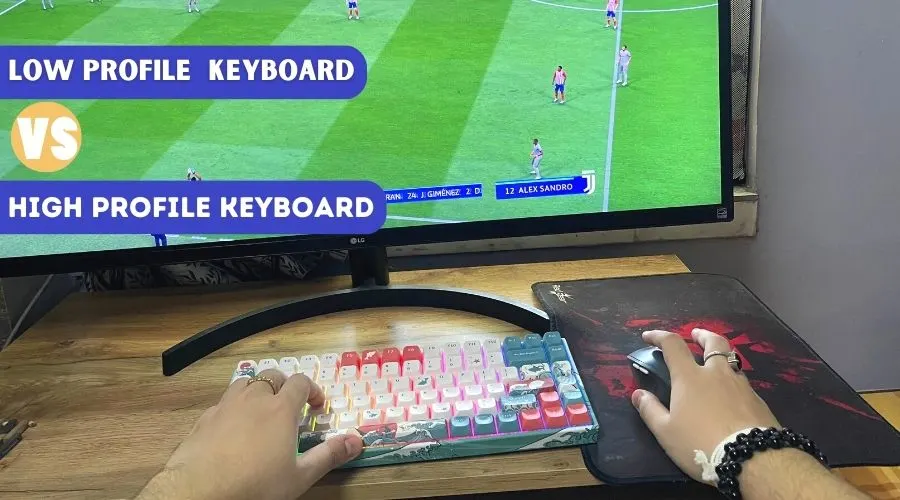When it comes to selecting the perfect keyboard, one of the critical factors to consider is the profile of the keys. This refers to the height of the keys, which significantly impacts your typing experience. There are two main types of keyboard profiles: low profile and high profile.
Low-profile keyboards have gained popularity in recent years due to their sleek and portable design. With their slim and lightweight build, they are ideal for travel and minimalist workspaces. However, some users may find them less comfortable to type on as the flatter keys may lack tactile feedback.
On the other hand, high-profile keyboards offer more tactile feedback and comfort during typing sessions. They have a bulkier build with keys that sit higher above the surface. While they may not be as portable, they are well-suited for extended gaming sessions and those who prefer a higher typing angle.
Key Takeaways
- Low-profile keyboards are thinner and lighter, but may lack tactile feedback compared to high-profile keyboards.
- High-profile keyboards offer better tactile feedback and comfort, but may be bulkier and less portable.
Low Profile vs. High Profile Keyboard Comparison Let’s take a closer look at the differences between low-profile and high-profile keyboards:
Low Profile Keyboard:
- Design: Slim, lightweight, and keys sit below the top piece of the keyboard.
- Switch Options: Typically use low-profile mechanical switches like Kailh Chocolate switches.
- Ergonomics: May require a wrist rest for comfortable typing.
- Availability: Increasingly popular but still less common compared to high-profile keyboards.
High Profile Keyboard:
- Design: Chubbier and heavier with keys sitting above the top piece of the keyboard.
- Switch Options: Offer a variety of mechanical switches, including high-profile options like Cherry MX.
- Ergonomics: Often more comfortable for users who prefer a higher typing angle.
- Availability: Widely available from major manufacturers such as Logitech, Corsair, and Razer.
Ergonomics Low-profile keyboards are generally more ergonomic as they have a shorter key travel distance, reducing strain on fingers and wrists. Their compact design also lowers the risk of carpal tunnel syndrome.
High-profile keyboards, while still ergonomic, may not match specialized options like split or ergonomic keyboards, but they do offer a more comfortable typing experience with a higher typing angle.
Portability
Low-profile keyboards win in terms of portability, being smaller and lighter, and often wireless. This makes them highly suitable for travelers and those working in tight spaces.
High-profile keyboards, being bulkier and heavier, are less portable but are sturdier and better suited for fixed locations.
Typing
Low-profile keyboards excel in typing, with their shorter key travel distance and actuation point enabling faster and more responsive typing. This makes them a popular choice for extended typing sessions.
High-profile keyboards, with their longer key travel and actuation points, are more favored by gamers for their tactile and satisfying typing experience.
Gaming
Low-profile keyboards are not the best choice for gaming, lacking the tactile feedback that many gamers prefer.
High-profile keyboards, with their satisfying tactile feel, are better suited for gaming, providing more precise keystrokes and a more immersive gaming experience.
Keycap Profile
Low-profile keyboards typically have flatter keycaps, providing a smoother typing experience, though some users may find them less tactile.
High-profile keyboards come with more pronounced curved keycaps, offering enhanced tactile feedback but may not be as comfortable for extended typing.
Switch Options
Low-profile keyboards often use low-profile switches, resulting in faster and more responsive typing, but may lack the satisfying feel of high-profile switches.
High-profile keyboards usually come with traditional mechanical switches, such as Cherry MX or Kailh, offering a more tactile and enjoyable typing experience.
Choosing the Right Profile for You In the end, the decision between low-profile and high-profile keyboards boils down to personal preferences and specific needs:
Low-profile keyboards are a great choice for those seeking a sleek design, portability, and comfortable typing experience for extended periods.
High-profile keyboards suit gamers and touch typists who prefer tactile feedback, better typing responsiveness and enjoy the traditional keyboard feel.
Keep in mind that both profiles have their advantages and disadvantages, so consider your typing style, gaming preferences, and comfort requirements before making your decision.
